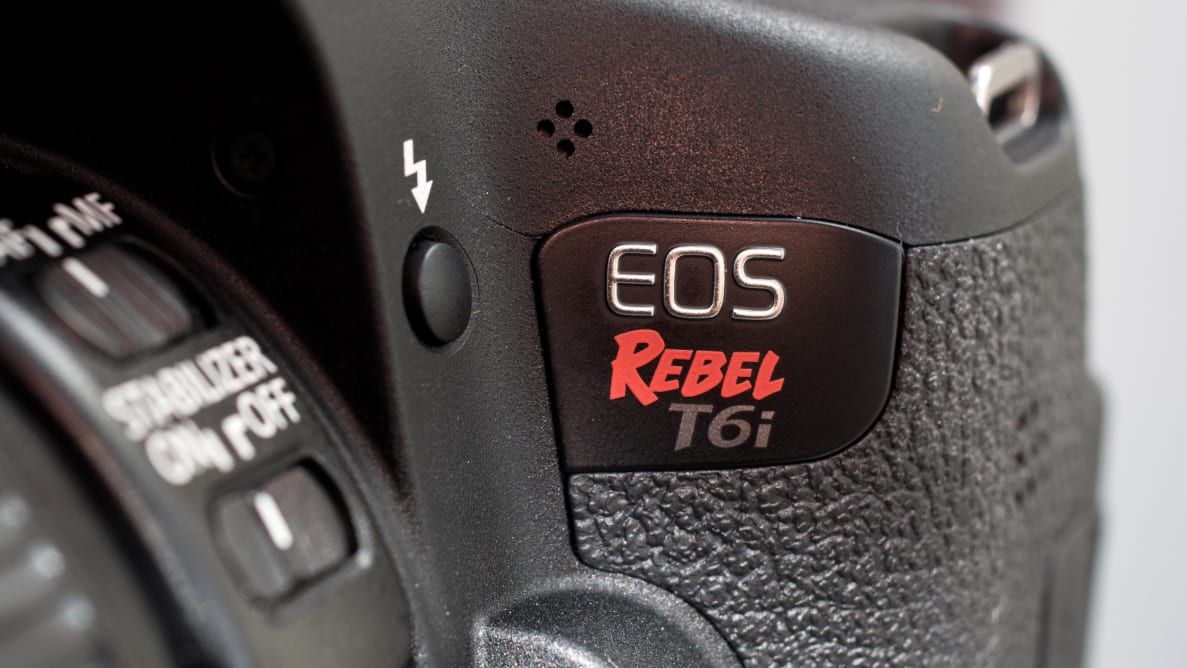Pros
-
Solid burst speed
-
Good video quality
Cons
-
None that we could find
Thanks to its ease of use, flexibility, and excellent performance, the T2i was so successful that Canon more or less coasted, changing very little from the T2i right on through to last year's Canon Rebel T5i. With the new Canon Rebel T6i (MSRP $749.99 body-only) that's all changing; Canon is finally giving the Rebel line an actual, honest-to-goodness update.
Still, don't expect Canon to completely upend the apple cart. The T6i looks and operates almost exactly like the T5i, but it also brings a few new features to the table that lead us think that this Rebel could be different. Built-in WiFi and NFC, a higher resolution 24-megapixel sensor, and supposedly improved low light and continuous shooting show that, this time, Canon means business.
Design & Handling
Evolution is slow, even for Rebels.
If you're looking for a drastic year-over-year change, the Canon Rebel line is not the place to look. While you eagle-eyed readers might notice that the T6i is a whopping 1% smaller and 4% lighter, it's more or less the same physical dimensions as past Canon DSLRs. Despite the name, there's more "evolution" than "revolution" to this Rebel.
If you compare the T6i to the now-ancient T2i, you'll undoubtedly notice a few buttons have shifted places. But other than some repositioned controls and an articulating screen, it's essentially like any other barebones DSLR. There's a large, accommodating grip, the lens mount, and a nice optical viewfinder to frame your shots with.
{{ photo_gallery name="Tour" }}
Like many manufactures, Canon stays away from drastic changes in these entry-level cameras due to their popularity and the ease of use they offer new users. The controls are very deliberate and well labeled, making it easy to pick up and start shooting—especially if you've used a Canon DSLR before. The touchscreen is also returning, which works wonderfully whether you're navigating menus, reviewing shots, or controlling the camera via live view.
The majority of the physical controls are on the rear of the camera. This is where you can access the menus, use the quick selectors, and playback images you've shot. You can control everything via touchscreen or use the dedicated buttons–of which there are plenty–to navigate through white balance, focus modes, drive modes, color modes, and more. In typical Canon fashion almost all of this can be operated with just your right hand, leaving the left hand free to support the camera or operate zoom/focus rings.
Overall, the T6i is a very straightforward camera—whether you've used a DSLR before or not. Personally, I'm used to using high-end DSLRs. So at first the T6i made me feel a little under-equipped. But after adjusting to the camera's design, it actually proved pretty capable. It's not a pro camera, but it doesn't really need to be.
Performance
This Canon shoots par—no better, no worse
For the last few years, it's seemed like every Canon Rebel was essentially the same. That's because since the T2i almost every Canon DSLR has used some variant of the same 18-megapixel CMOS sensor. The new T6i is the first big step forward Canon's made in this department in some time. The new sensor features an upgraded hybrid autofocus system built into the sensor and 24.2 megapixels of resolution. Canon's also given this its newest Digic 6 processor and an improved 19-point (all cross-type) phase-detect autofocus system.
The new sensor and processor are much needed updates and provide performance gains that've been lacking for years. The sensor alone provides a 30% increase in system resolution and the new processor (with expanded memory) essentially eliminates buffering when shooting JPEGs. Even with these upgrades, your images aren't going to produce very much detail with the 18-55mm f/3.5-5.6 kit lens that it comes with. If you want to maximize results with the T6i, do yourself a favor and pick up another lens.
{{ photo_gallery name="Samples" }}
The T6i's new autofocus system has more than twice as many phase-detection points to choose from when framing with the optical viewfinder–19 up from nine, all cross-type sensitive. Phase detection autofocus works by splitting the incoming image into two. If they aren't lined up, then the subject is out of focus. The distance between these two images lets the camera calculate how far out of focus it is, and–crucially–which direction to go in.
However, when shooting in live-view or video, the T6i has a hybrid system that uses phase-detect pixels that are built right into the image sensor. It also uses contrast autofocus–the same as what you'd use with most smartphones and point-and-shoot cameras. Contrast-based AF is more accurate, but slower, as it just moves the lens in one direction until the contrast (and the focus) hits it peak. The reason this hybrid system works so well is because uses phase detect to quickly get into the right ballpark and contrast to get the exact spot.

EXIF: 55mm, ISO 100, 1/400, f/5.6
In our lab tests, the T6i produced similar results to past Canon. The camera was able to render very accurate colors, with Standard mode being the most accurate color mode available. All other color modes are reasonably accurate as well, with the exception of Landscape, which bumps up saturation, giving you vivid–if inaccurate–colors.
White balance is another strength that Canon didn't let slip on the T6i. We observed extremely accurate color temperatures while shooting in every kind of light. The difference between custom and auto white balance modes in both fluorescent and daylight was marginal at best and the only type of light that the T6i struggles with was incandescent light–resulting in a very warm image. However, simply using custom white balance or shooting RAW (and correcting in post) easily fixes this problem.
Video performance on the T6i is slightly improved from the T5i, but it's still limited to 1080p. This results in shots that are have that cinematic DSLR look, but are half as detailed as 4K videos. However, low-light sensitivity and video smoothness are both great for a DSLR in this range. Either way you've got full manual control, letting you take control of your shot.
Features
All about that WiFi–no GPS
The T6i is now equipped with built-in WiFi, making sharing photos between compatible devices easier than any Rebel before. This allows users to connect to the camera with Canon's new Camera Connect App using an iPhone or Android device. Additionally, Android users and people that pick up Canon's Connect Station CS100–which lets you store, view, and organize all of your photos and videos–can connect to the devices via Near Field Communication (NFC).
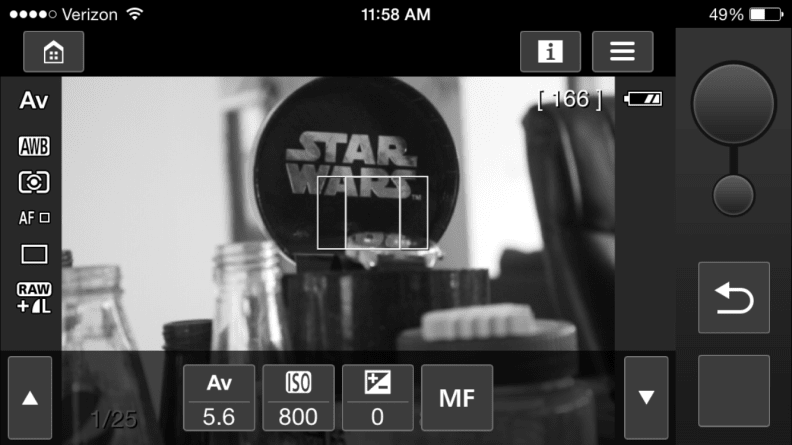
The Camera Connect app allows you to use the T6i remotely.
Once connected, users can remotely control the camera, which can be used for selfies, group shots, or changing settings from afar. Using the Camera Connect App lets you select different shooting modes, manage AF frame modes, change drive mode, and access the autofocus button. The app is pretty straight-forward, but still far more functional than its Nikon counterpart.
The T6i, like its predecessor, is equipped with an articulating 3-inch, 1.04 million-dot touchscreen LCD monitor that uses capacitive technology—the same tech found in your smartphone. The screen is responsive and is capable of multi-touch gestures, which is perfect for zooming in on images. Menus can be navigated with ease and users can use touch-to-focus for accurately focusing on subjects for both stills and videos. Additionally, the monitor is great at keeping away smudges, though it is prone to glare (as seen below), which limits usability in some bright environments.
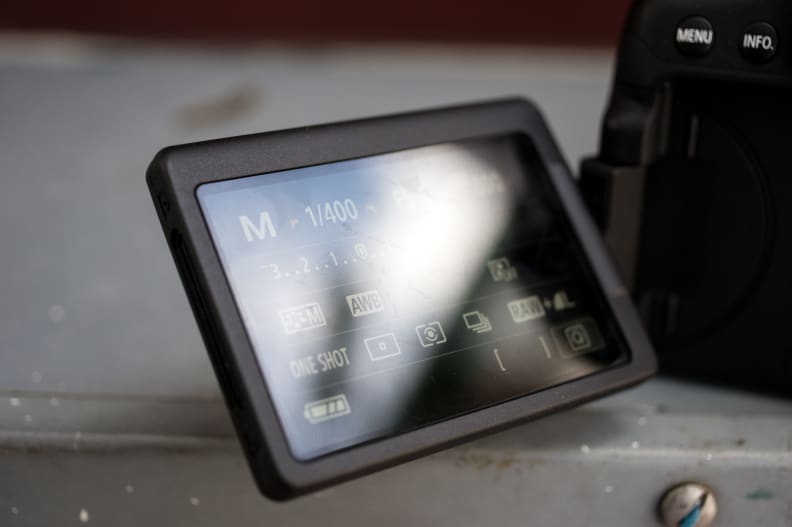
The monitor is quite prone to glare.
Capable of five frames per second (fps) burst shooting, the T6i doesn't have a buffering limit when shooting JPEG images thanks to the new Digic 6 processor with its increased memory. However, when shooting RAW or RAW + JPEG, you'll only get around six shots before the camera has to stop and catch its breath.
Finally, like most entry-level DSLRs, the T6i comes with a number of different creative filters. These can be previewed before shooting and include effects like Water Painting, Soft Focus, Toy Camera, Grainy Black and White that are available in both still and movie mode.
Conclusion
A long-overdue update
Once upon a time, Canon dominated the sub-$1,000 DSLR space, with few cameras that could even measure up. These days that part of the market is more crowded than ever, and Canon has five separate (but similar) DSLRS under $1,000. The new T6i and T6s are the newest kids in the club, joining the T5i, T5, and SL1–which are older, but still relevant.
There's a downside with having so many cameras in the same price range, though: it can be tough to pick one. If you're dead set on Canon, you've got a couple options to sift through, starting at the top with the T6s. The T6s offers very similar performance to the T6i but with a high-end DSLR layout–with the top LCD, locking mode dial, and rear control wheel.
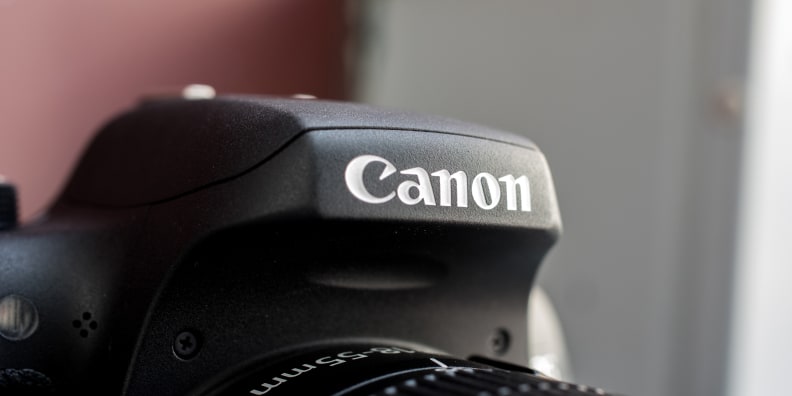
Stepping down is the T6i, which loses a few features, but has nearly identical performance. The T5i uses the older 18 MP sensor and lacks built-in WiFi, but will save you around $100 right now. The SL1 is essentially a smaller T5i, but costs only $400 these days. Finally, the T5 gives you the least amount of features and performance, but is also only $400 right now.
If you're not set on getting a Canon, things open up even more. Nikon's D5500 outperformed the T6i in almost every way and currently costs the same price. There are also mirrorless options, like the Sony A6000 or the Olympus OM-D E-M10 that are more compact and faster than the Canon Rebels, but a little more difficult to use.
It's that ease of use that keeps people coming back to Canon. The T6i isn't simple, but it has a shallower learning curve than most of its competition, making it easier for novices who are interested in photography to start practicing their craft. It's still not the best, but that ease of use, coupled with the improvements Canon's made to performance, make the T6i a solid pick for novice shoppers—just make sure you get a better lens to go with it.
By the Numbers
We've already established that the T6i is the first performance upgrade that Canon has applied to the Rebel series since the T2i back in early 2010. Those upgrades serve the T6i well by upgrading resolution, sharpness, shooting limit, and focusing. It isn't a revolutionary leap forward by any stretch, but it at least brings the Rebel series in line with most of its peers.
Below you can read more about how the T6i performed in our specific lab tests.
Color Accuracy & White Balance
All of the color modes on the T6i are fairly accurate with the exception of Landscape–which boosts saturation as intended. If you're looking for the most accurate color possible, it's the Standard mode. Standard mode chimed in with a ∆C00 of 2.32, which is a bit worse than the best color mode on the T5i, but still good for an entry-level DSLR.
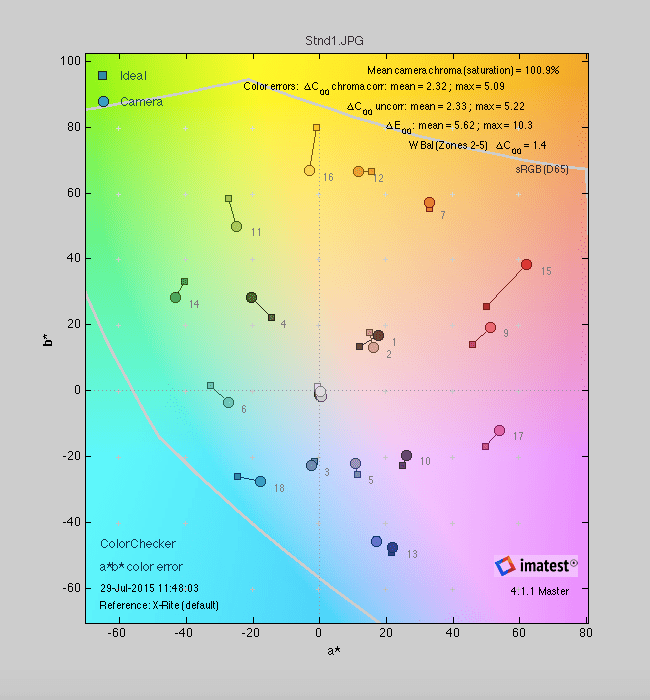
White balance is once again fantastic. Canon has proven time and time again that it knows white balance and the T6i is no different. Auto was able to keep daylight and fluorescent lighting within 100 kelvins almost every time. It did struggle a bit with incandescent–as most cameras do–but the custom setting and shooting RAW is an easy remedy.
Sharpness
The T6i's new processor is responsible for a 30% increase in resolution and we observed an increase in quality that reflected just that. While a new processor and sensor certainly make much needed improvements in quality, the T6i is being held back by its kit lens. The 18-55mm f/3.5-5.6 STM that comes with most of Canons kits in this range–while great for videographers because of silent focusing–is simply awful at capturing the fine details you'll expect out of a DSLR.
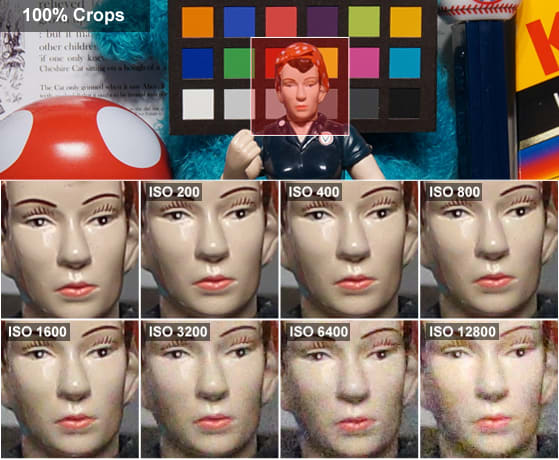
In our sharpness testing we found that many of the finest details are simply muddy and lack that pop that most users stepping up from a point and shoot system are going to be looking for. Do yourself a favor and ditch the kit lens for a nifty fifty or just about any other lens in Canon's arsenal.
Video Performance
Most people will be fine with the 1920/30p video quality that the T6i offers users, but if you're looking to do more than capture family gatherings, little league games, or the like, you'll be disappointed. This comes back to the same issues of sharpness.
We observed an average lp/ph (line pairs per picture height) value of 550 horizontal, 500 vertical in bright light which dropped to 450 lp/ph vertically and horizontally in low light. The T6i isn't particularly sharper than its predecessor and it still lacks that pop that people are going to expect when they purchase their first DSLR.
Again, this isn't entirely on the camera, but the lens. The great part about the lens is that it can focus silently, so you can film graduation without that mechanical focusing ruining the ceremony for the people around you. The bad part is the lens just doesn't do the camera justice. With the video resolution topping out at 1080p no lens is going to give you 4K-level results, but the kit lens also doesn't give you the creamy, smooth depth of field you expect from DSLR video.
Meet the tester
As a photojournalist, Jackson has had stints working with bands, the military, and professional baseball teams before landing with Reviewed. Outside of Reviewed, he can be found looking for the next game to relieve his "Gamer ADD" or growing his beard.
Checking our work.
Our team is here to help you buy the best stuff and love what you own. Our writers, editors, and experts obsess over the products we cover to make sure you're confident and satisfied. Have a different opinion about something we recommend? Email us and we'll compare notes.
Shoot us an email